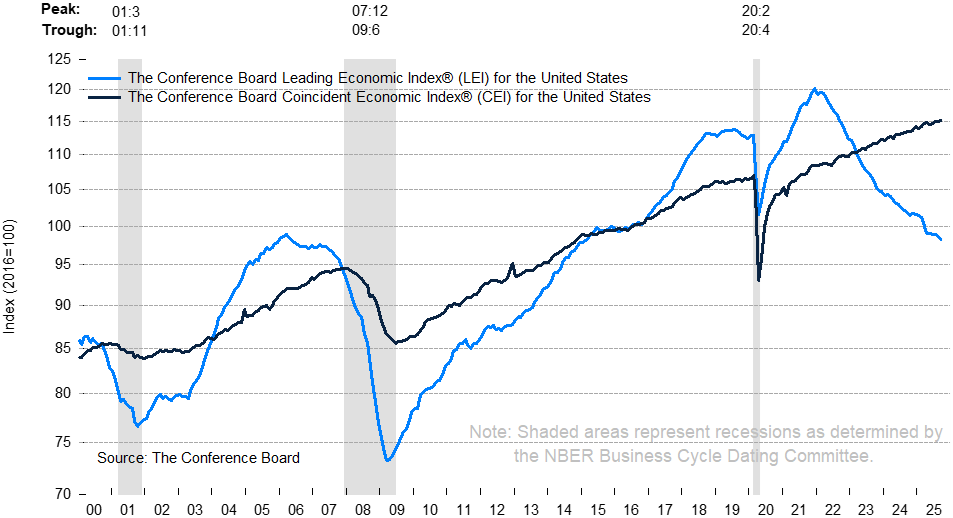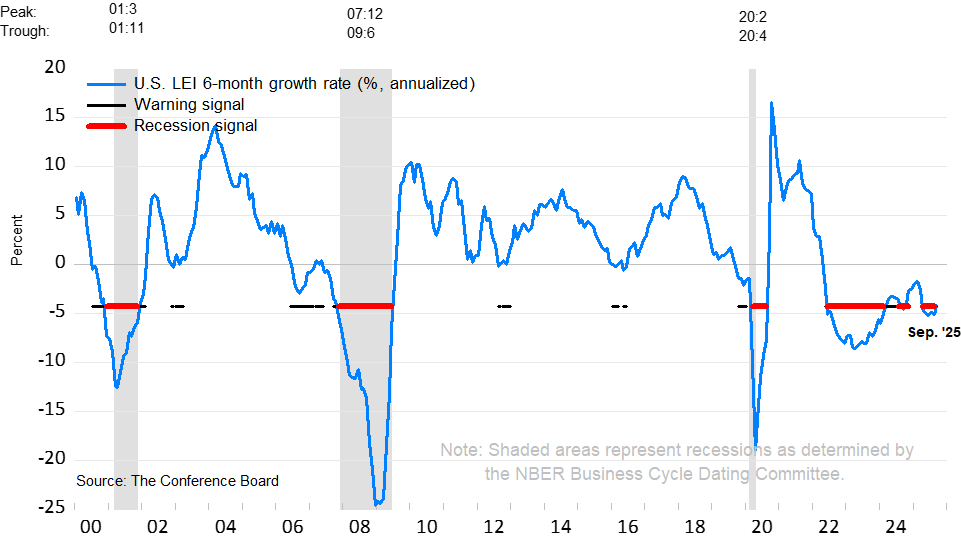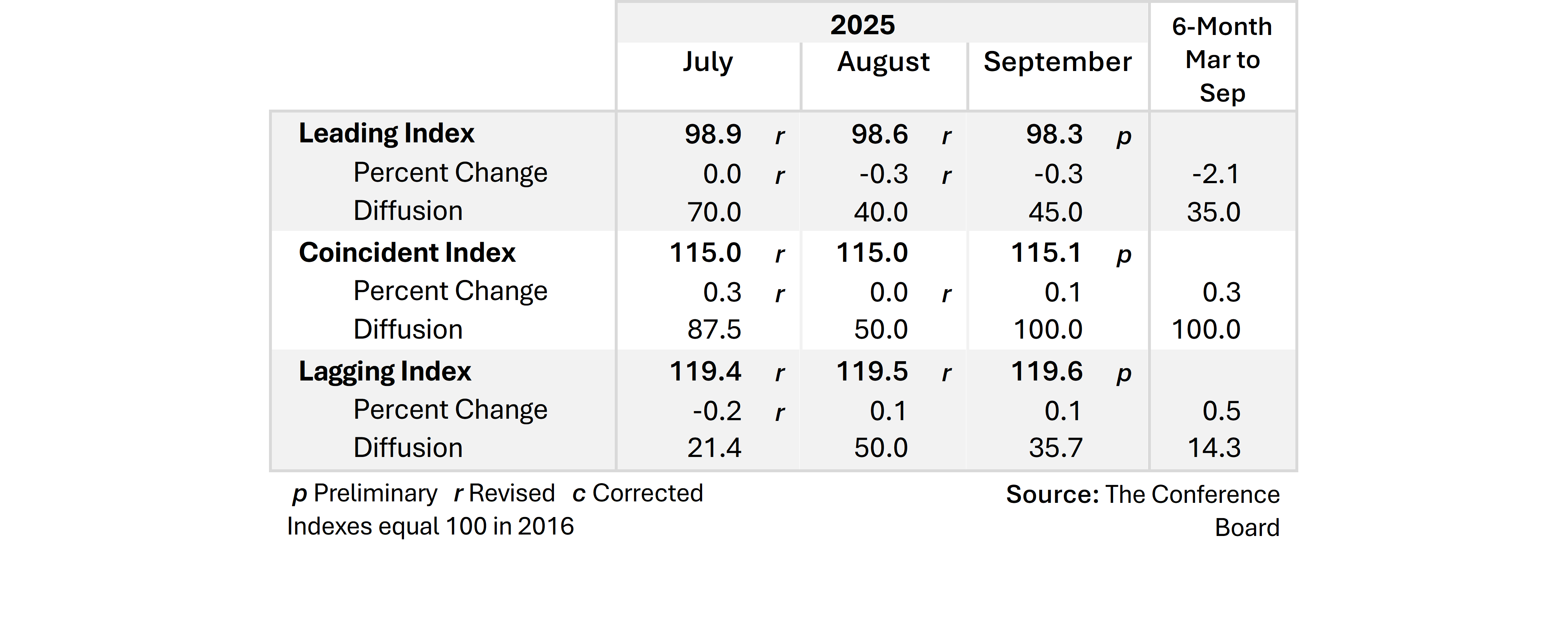The Conference Board publishes leading, coincident, and lagging indexes designed to signal peaks and troughs in the business cycle for major economies around the world.
The Conference Board Leading Economic Index® (LEI) for the US Declined Again in September
Latest Press Release
Updated: Tuesday, December 9, 2025
Using the Composite Indexes: The Leading Economic Index (LEI) provides an early indication of significant turning points in the business cycle and where the economy is heading in the near term. The Coincident Economic Index (CEI) provides an indication of the current state of the economy. Additional details are below.
The Conference Board Leading Economic Index® (LEI) for the US declined by 0.3% in September 2025 to 98.3 (2016=100), after also declining by 0.3% in August (upwardly revised from an originally reported 0.5% decline). Overall, the LEI fell by 2.1% over the six months between March and September 2025, a faster rate of decline than its 1.3% contraction over the previous six-month period (September 2024 to March 2025).
“The US LEI fell again in September, marking a second consecutive decline,” said Justyna Zabinska-La Monica, Senior Manager, Business Cycle Indicators, at The Conference Board. “Weakening expectations from consumers and businesses led the overall contraction in the Index. Subindexes that contributed negatively to the LEI were consumer expectations and ISM® New Orders Index, followed by manufacturers' new orders of consumer goods & materials, initial claims for unemployment Insurance (inverted), and the yield curve. However, stock prices, the Leading Credit Index, and manufacturers' new orders of nondefense capital goods excl. aircraft did contribute positively to the Index. The LEI suggests slowing economic activity at the end of 2025 and into early 2026, with GDP weakening after strong mid-year consumer spending and Q4 disruptions amid the federal government shutdown. Overall, growth remains fragile and uneven as businesses adjust to tariff changes and softer consumer momentum. The Conference Board expects GDP to expand by 1.8% in 2025, before falling to 1.5% in 2026.”
The Conference Board Coincident Economic Index® (CEI) for the US rose by 0.1% in September 2025 to 115.1 (2016=100), following no change in August (downwardly revised from a 0.2% gain). The CEI rose by 0.3% between March and September 2025, down from 1.1% over the previous six months. The CEI’s four component indicators—payroll employment, personal income less transfer payments, manufacturing and trade sales, and industrial production—are included among the data used to determine recessions in the US. Three components of the coincident index improved slightly in September. Manufacturing and trade sales, which was estimated for August and September, was also positive.
The Conference Board Lagging Economic Index® (LAG) for the US inched up by 0.1% to 119.6 (2016=100) in September 2025, after also increasing by 0.1% in August. The LAG grew by 0.5% in the six months between March and September 2025, slightly lower than the 0.6% increase over the previous six months.
Note on US LEI data for September 2025
Due to a lag in publication of the Census Bureau’s September building permits data, the series is estimated via statistical imputation using an autoregressive model.
The next release will be announced at later date.
The LEI declined again in September

Most non-financial components and the yield spread continued to weigh on the LEI’s

The LEI’s growth rate over the past six months turned less negative, preventing triggering of the recession signal in September

NOTE: The chart illustrates the so-called 3Ds—duration, depth, and diffusion—for interpreting a downward movement in the LEI. Duration refers to how long the decline has lasted. Depth denotes the size of decline. Duration and depth are measured by the rate of change of the index over the most recent six months at an annualized rate. Diffusion is a measure of how widespread the decline is among the LEI’s component indicators—on a scale of 0 to 100, a diffusion index reading below 50 indicates most components are weakening.
The 3Ds rule signals an impending recession when: 1) the six-month diffusion index lies at or below 50, shown by the black warning signal lines in the chart; and 2) the LEI’s six-month growth rate (annualized) falls below the threshold of −4.3%. The red recession signal lines indicate months when both criteria are met simultaneously—and thus that a recession is likely imminent or underway.
Summary Table of Composite Economic Indexes

About The Conference Board Leading Economic Index® (LEI) and Coincident Economic Index® (CEI) for the US
The composite economic indexes are key elements in an analytic system designed to signal peaks and troughs in the business cycle. Comprised of multiple independent indicators, the indexes are constructed to summarize and reveal common turning points in the economy in a clearer and more convincing manner than any individual component.
The CEI reflects current economic conditions and is highly correlated with real GDP. The LEI is a predictive tool that anticipates—or “leads”—turning points in the business cycle by around seven months.
The ten components of the Leading Economic Index® for the US are:
- Average weekly hours in manufacturing
- Average weekly initial claims for unemployment insurance
- Manufacturers’ new orders for consumer goods and materials
- ISM® Index of New Orders
- Manufacturers’ new orders for nondefense capital goods excluding aircraft orders
- Building permits for new private housing units
- S&P 500® Index of Stock Prices
- Leading Credit Index™
- Interest rate spread (10-year Treasury bonds less federal funds rate)
- Average consumer expectations for business conditions
The four components of the Coincident Economic Index® for the US are:
- Payroll employment
- Personal income less transfer payments
- Manufacturing and trade sales
- Industrial production
To access data, please visit: https://data-central.conference-board.org/
About The Conference Board
The Conference Board is the member-driven think tank that delivers Trusted Insights for What’s Ahead®®. Founded in 1916, we are a non-partisan, not-for-profit entity holding 501 (c) (3) tax-exempt status in the United States. TCB.org







